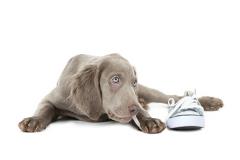NEED REGULATORY ASSISTANCE?
If you need help with regulatory or licensing issues, we're happy to help. We have a wide variety of resources to help you when issues arise.

Blog Post
Help for Clients of Dogs with Pica

There are so many decisions to make when choosing the right dog food for a pet! Not only do clients worry about protein, fat, vitamin and mineral content, but there is also a concern over whether their pet will find it palatable. When provided with balanced and nutritious diets, why then do some dogs feel the need to consume nonfood items?
Pica
Pica is a disorder that occurs in dogs when the animal feels a need to consume nonfood items. This behavior can be found in all stages of a dog’s life.
Normal Explanation for Pica
When a dog seeks out nonfood items to eat, it is usually either an indication that their diet is not nutritiously balanced, or they are bored. Puppies, on the other hand, are curious eaters, and for a while they will eat just about anything they come across as they explore their environment. Choosing to eat nonfood items for these reasons are understandable.
When Pica Becomes a Disorder
Animals with pica sometimes develop a compulsive behavior to their eating of nonfood items. Dogs that have developed this disorder search with the intent to consume a specific nonfood object, which may include such things as:
- Rocks
- Wool or other fibers
- Rubber
- Their own hair
- Wood
- Clothing
- Shoes
- Plastic bags
This type of pica is a compulsive disorder that has become a repetitive behavior that serves no function and is of no benefit to the animal.
Cause
There is no exact cause for this type of compulsive disorder, but the start of pica may be attributed to:
- Stressful environmental issues
- Competition with other pets
- Extended confinement in cages or crates
- Changes in the home, such as a move
- Lack of socialization, or the opposite, too much attention
- Nutritional imbalance
Clients need to keep in mind that an animal with this type of compulsive disorder has no control over their behaviors. Without their owner’s help through behavioral training, they will not be able to stop these negative, obsessive actions.
Suggestions for Clients to Help Their Dogs
The American Society for the Prevention of Cruelty to Animals (ASPCA) recommends several tips for clients with an animal exhibiting a pica problem, which include:
- Start by consulting with the veterinarian
- Rule out any physical problems, such as:
- Digestive disorder
- Parasitic infestation
- Metabolic disorder
- Nutritional deficiency
- Dietary imbalance
- Poisoning
- Allergies
If there are no physical problems, clients should concentrate on changing the obsessive behavior:
- Provide appropriate items for playing and chewing
- Provide plenty of physical exercise opportunities
- Going on walks
- Playtime at the dog park
- Provide interactive play time
- Tug-of-war
- Fetch
- Monitor the amount of time the dog spends alone, in a crate, or in a cage
Additional steps that help to eliminate the compulsive pica behavior may include:
- Basket-muzzle animal
- This will eliminate the dog’s opportunities to quickly snatch up and swallow any nonfood items, but will still allow them to breath and drink
- Verbally discourage animal when they pick up something they shouldn’t eat
- Train dog with the following cues:
- “come” – use to call them away from a potential item they may eat
- “leave it” – use to command the dog to leave an item alone
- “drop it” – use to get the dog to drop an item before swallowing
- Use taste deterrents that are safe for dogs by applying them to the dog’s choice of nonfood items
- Safe deterrent choices may include:
- Finely ground black pepper
- Crushed hot pepper
- Use a remote device that issues a punishment to the dog such as an air horn or a collar that spritzes citronella.
Since compulsive pica is a disorder, these suggestions may not work. In that case, it is recommended that clients talk with their veterinarian and ask for help in finding either a Certified Applied Animal Behaviorist or a veterinary behaviorist.
If you are looking for more information on animal disorders, please contact your Covetrus representative today at 855.724.3461.
Source:
https://www.aspca.org/pet-care/virtual-pet-behaviorist/dog-behavior/pica-eating-things-arent-food
Careers
Are you looking for a place to let your talents shine? At Covetrus, we help our practitioner customers better serve their patients and take pride in providing the best customer experience possible. Search our open positions to see our available opportunities.
Newsletter
Stay current with what’s going on with Covetrus, subscribe to receive our newsletter and email communications. Subscribers will receive the latest information in practice management, sales and marketing, animal health, and more.


Leave a comment